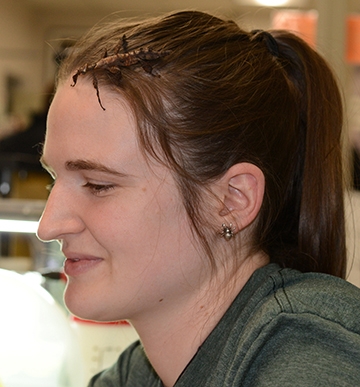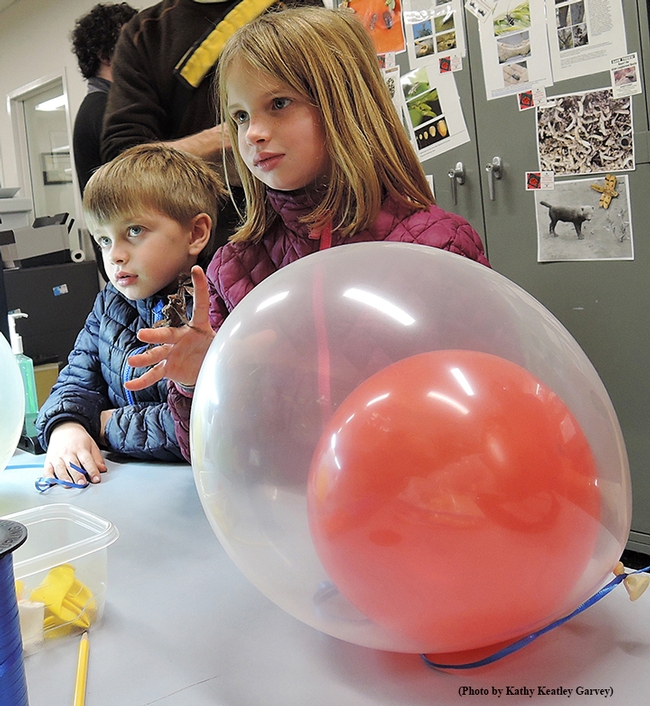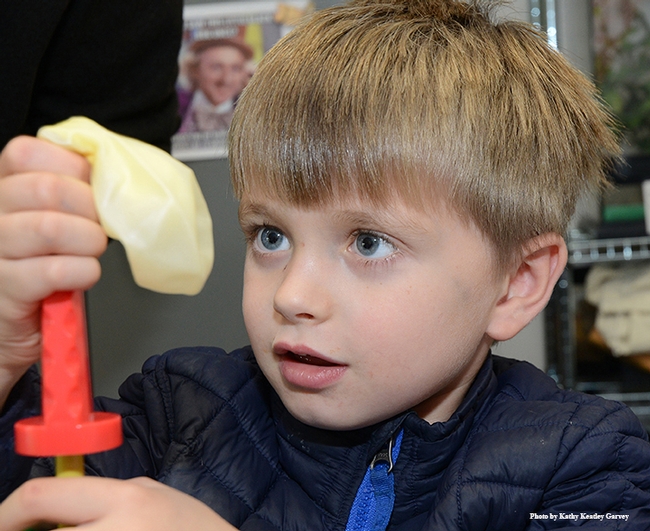
Well, if you're the Bohart Museum of Entomology at the University of California, Davis, you do it with a family craft activity--inflating a balloon inside a balloon to get a "parasitoid" balloon.
Graduate student Charlotte Herbert, who studies with major professor Lynn Kimsey, director of the Bohart Museum and professor of entomology at UC Davis, staffed the "balloon station" at the Bohart Museum's "Parasitoid Palooza II" open house.
Adi Fry, 7, and her brother, Ethan Fry, 5, of Davis, were among those who learned about parasitoids as they inflated the double balloons.
"An insect parasitoid is a species whose immatures live off of an insect host, often eating it from the inside out," said Tabatha Yang, education and outreach coordinator. "It is part of their life cycle and the host generally dies. This sounds like a weird way to make a living, but there are more species of parasitoids than there are insects with any other kind of life history.” An example is a conopid fly that lays its eggs inside a bumble bee.
On the other hand, an insect parasite is a species that feeds on living animal tissue as external or internal parasites of any stage of another organism, according to Kimsey. This is part of their life cycle and the host typically does not die. An example is a flea feeding on a dog.
Rosemary Malfi, a postdoctoral fellow in the lab of Neal Williams, UC Davis Department of Entomology and Nematology, discussed conopid flies, also called thick-headed flies, which lay their eggs in some bees, wasps and ants. Malfi did extensive work on the interaction between conopid flies and bumblebee hosts. Some 800 known species of conopids are found throughout the world.
Bohart senior museum scientist Steve Heydon discussed jewel wasps, Pteromalidae, a worldwide family of wasps with some 3,450 described species. Many are biological control agents.
The next open house at the Bohart Museum will be part of the fifth annual Biodiversity Museum Day, a campuswide open house scheduled from 9 a.m. to 4 p.m. Saturday, Feb. 13. The "Super Sciene Day" will showcase 11 specialized research and teaching collections. It is free and open to the public.
New to the Biodiversity Day are the Nematode Collection, Häagen-Dazs Honey Bee Haven, California Raptor Center, Phaff Yeast Culture Collection and the UC Davis Arboretum and Public Garden. They will join the Center for Plant Diversity, Botanical Conservatory, Paleontology Collections, Anthropology Collection, Museum of Wildlife and Fish Biology, and the Bohart Museum of Entomology for a day of science exploration.
The Bohart Museum, named for noted entomologist Richard Bohart, houses nearly eight million insect specimens, along with a live "petting zoo" (Madagascar hissing cockroaches, walking sticks and a rose-haired tarantula named "Peaches") and a year-around gift shop. It is located in Room 1124 of the Academic Surge Building on Crocker Lane. The Bohart hosts open houses on specific weekends throughout the academic year, but it is also open to the public from 9 a.m. to noon, and 1 to 5 p.m., Mondays through Thursdays.
Attached Images:

Wide-eyed Ethan Fry, 5, and his sister Adi Fry, 7, of Davis, listen to graduate student Charlotte Herbert at the "parasitoid" balloon station at the Bohart Museum of Entomology. (Photo by Kathy Keatley Garvey)

Ethan Fry, 5, of Davis, inflates a balloon at the "parasitoid" balloon station. (Photo by Kathy Keatley Garvey)